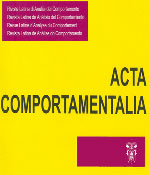Naming the stimuli and the emergence of equivalence relations of location
DOI:
https://doi.org/10.32870/ac.v8i1.14650Keywords:
equivalence, location, naming, adults.Abstract
Does stimulus naming facilitate the mergence of equivalence relations of location? To investigate this question, three high-school and three college students were submitted to a matching-to-sample procedure and taught six associated pairs (3 AB, 3 CB) relating nine locations. Relations AC and CA were tested in extinction to document eventual equivalence class formation. The same procedure was repeated with different pairs of locations, up to three times. If equivalence did not emerge in first testing the subject was asked to name the stimuli, i.e. each of the nine squares in a three by three matrix before training of the second set of relations. Six associated pairs of Greek letters were then taught and tested for equivalence class formation. A microcomputer presented the stimuli and recorded data. After all test the subjects were asked to justify their responses. One subject showed emergent equivalence relations after naming. Another subject showed emergent equivalence relations in the first configuration, before naming was required. The comparisons chosen by the other four subjects were related to the sample according other relations of location than equivalence. Three of these did not show emergence of equivalence relations of Greek-letters either. Subjects who did show equivalence justified their performance accordingly. Those who did not show equivalence referred to their performance in test as the reverse of trained relations, or as orderless, just aiming to go on with the trials. Naming the stimuli, i.e. the locations, did not facilitate the emergence of untrained relations. The role of the “complex-to-sample” testing procedure, the fixed and reduced number or test trials, the testing in extinction, the type of naming used, and the possible absence of conditionality in the trained relations are considered in the discussions. Further research is proposed to establish the conditions for the emergence of equivalence relations of location.
Downloads
Downloads
How to Cite
Issue
Section
License

<a rel="license" href="http://creativecommons.org/licenses/by-nc-sa/4.0/"><img alt="Licencia de Creative Commons" style="border-width:0" src="https://i.creativecommons.org/l/by-nc-sa/4.0/88x31.png" /></a><br />Este obra está bajo una <a rel="license" href="http://creativecommons.org/licenses/by-nc-sa/4.0/">licencia de Creative Commons Reconocimiento-NoComercial-CompartirIgual 4.0 Internacional</a>.






